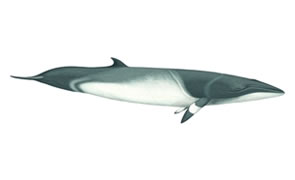Species Index


Key Facts
Length: Up to 10 metresRange: Throughout the Northern hemisphere, except the Arctic Ocean
Threats: Marine litter, pollution, commercial whaling, ship strikes
Diet: Small schooling fish and some plankton
Minke Whale
Latin: Balaenoptera acutorostrata
Gaelic: Muc-mhara-mhionc
Physical Description
The minke whale is the smallest of the baleen whales found in UK waters, measuring 7 to 10 metres when fully grown. Females are usually slightly longer than males. The body of a minke whale is slender and very streamlined; the head is narrow and pointed. The small dorsal fin is usually strongly falcate (curved) and is a unique feature used to identify individual animals in the Hebrides. It is positioned about two-thirds of the way down the back and is visible at the same time as the blowhole when the animal surfaces. The blow is not normally visible at sea. The dorsal fin and back are dark grey or black, the belly is bright white and there is a distinctive white band on the upper side of each pectoral (side) fin. Lifespan is estimated at around 40 to 50 years.
Habitat and Distribution
Amongst the most widely distributed of all baleen whales, the minke whale is found from the tropics to the ice edges in the northern hemisphere. The annual movement patterns of minke whales are not fully understood but they are thought to make a general migration between tropical breeding grounds in the winter, and colder feeding regions during the summer. Minke whales are frequently seen in coastal and in-shore waters around the Hebrides from April to October. The Hebridean Whale and Dolphin Trust have identified over 65 individuals using photo-identification of their dorsal fins. View the Minke Whale Photo-Identification Catalogue.
Behaviour
Minke whales are generally solitary, although they can sometimes be seen in feeding groups of up to 10 animals. The minke whale is capable of swimming at speeds of up to 13 mph. Their typical dive sequence is five to eight blows at intervals of less than a minute, followed by a dive which usually lasts three to eight minutes. Some minke whales appear to be inquisitive around boats and will sometimes come close and even spy-hop (raise just the head out of the water) to investigate. They have been observed breaching clear of the water in the Hebrides.
Food and Foraging
The diet of minke whales in the Hebrides includes a variety of fish species, including sandeel, herring and whiting, along with some plankton. There are 230 to 360 baleen plates in each side of the upper jaw; these are coarse, hair-like structures formed of keratin that hang down into the mouth. They feed by engulfing large volumes of prey and water, and they then sieve the water back out through the baleen plates and swallow their prey whole. A commonly sighted feeding behaviour, known as lunge feeding, involves the whale lunging at its prey at high speed from below and erupting at the surface with the throat grooves extended. Minke whales in the Hebrides are commonly seen feeding in association with seabirds, in particular kittiwakes, Manx shearwaters and young gulls.
Status and Conservation
Research by HWDT has shown a decline in sightings of minke whale in the Hebrides during recent years, which is likely to be related to prey distribution and availability. Further research will investigate whether this trend continues in future years. Collisions with ships may also pose a threat as there have been at least two recent records of minke whales being killed in ship collision in UK waters. Minke whales are also exposed to marine litter, which can get caught on fins or around the head and cause injury and problems with mobility, and there are some reports of minke whales becoming entangled in fishing nets and static fishing gear in the UK. Local boat operators have reported whales with plastic strapping (and the resulting scars) caught around their bodies. Seismic surveys during gas and oil exploration may cause cetaceans, including minke whales, physical harm at close ranges. This species is still a target of commercial whaling, which continues in the North Atlantic and Antarctic, but not in UK waters. Minke whales are protected under UK and EU law, principally under Schedule 5 of the Wildlife and Countryside Act 1981, the Nature Conservation (Scotland) Act 2004 and by the 1992 EU Habitats and Species Directive.





